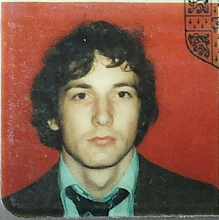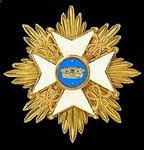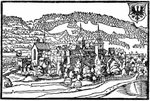Friday, 17 September 2010
British Light Infantrymen, North America 1759
Light troops were much in demand in North America and "the most active resolute men" from the regular line regiments were selected to form a body of Light Infantry. Generals Amherst and Wolfe ordered their light infantrymen to put the sleeves of their coats on their waistcoats, add wings like those of grenadiers but larger and to extend down the sleeve, to have no lace but to keep the lapels, and to add two extra pockets of leather for ball and flints. They were to carry a knapsack "as the Indians carry their pack", that is, very high between the shoulders, have a cartouche box under the arm on the left side suspended from a leather strap, carry a canteen covered with cloth under the knapsack and have a tomahawk in a rough case with a button in a leather sling at the side. Fusil, bayonet and powder horn were also carried. The leggings had leather straps under the shoes and the tricorn hat was cut down into a cap and flaps added so that it could be fastened under the chin for warmth. The result was not pretty and must have given many of the more traditional officers and NCOs apoplexies but it was practical.
Initially the light infantry fought with the rangers on guerilla operations but in 1759 they led the army up the Heights of Abraham to Quebec. In 1760 they were returned to their regiments but the experiment was not forgotten and in 1770 line infantry regiments were given light infantry companies to make 10 companies per battalion (including 8 battalion or "hatmen" companies and a grenadier company). (Already in 1755 some regiments had been experimenting with "picquet" companies which were also forerunners of the light company and which were copied from the French.)
Posted by
David Morfitt
at
Friday, September 17, 2010
![]()
Subscribe to:
Post Comments (Atom)





















Something only a Brit could wear in the wilderness without embarrasment! Glad to see you posting...
ReplyDeletenice indeed
ReplyDeleteHi Bill,
ReplyDeleteThanks.
Well, that was one that the Brits. did win so they must have been doing something right - not so lucky the next time, of course. ;-) I know they do look a bit odd but for the time they were pretty practical and dictated by the needs of the troops in the field.
Hope all's going well for you and your wife (not forgetting the cats, of course).
All the best,
David.
Thanks, CH! :-)
ReplyDeleteCheers,
David.
A very interesting uniform plate, David. I've seen pictures of these campaign uniforms, but I don't think I've seen them with the brown pockets before. Were they for something specific?
ReplyDelete@Capt Bill
There is no way that my (at times unbelievably jingoistic) mind can justify the hat on the left. That said if I was p***-wet through in freezing cold, 18th century North America I might change my opinion. But, then I look at this picture and think that perhaps style should sometimes take precedence over practicality:
http://d.yimg.com/i/ng/sp/empics/20100412/15/288331289-horse-racing-2010-john-smith-grand-national-day-aintree-racecourse.jpg
Hi Adam,
ReplyDeleteThanks. :-) Yes, the extra pockets were quite specific in use; Captain John Knox's Journal for May 1759 says: "besides the usual pockets, he has two, not quite so high as his breast, made of leather, for ball and flints; and a flap of red cloth on the inside, which secures the ball from rolling out, if he should fall."
I agree it's *some* hat - and for the next century or so the regulations for British troops did indeed allow style to take precedence over practicality, with e.g. stocks and tall ungainly leather shakoes and backpacks that looked smart but gave men hernias and back trouble, even in the light infantry. In practice, of course, British troops didn't let the regulations get in the way of comfort (think of the road to the Alma in 1854 littered with discarded stocks and masses of other abandoned equipment by the advancing army) - and anyway shortages in the field usually meant that after a very short time on campaign they were reduced to wearing rags or whatever they could pick up along the way. I was reading a book about Dunkirk recently and was struck by descriptions of British troops coming back in dressing gowns and tattered tailcoats and top hats. Clearly it doesn't take long even for a fairly modern British army to look a bit unorthodox! ;-)
And yes, there's absolutely no excuse for looking like that at the racecourse - but I bet that on campaign ("p***-wet through in freezing cold, 18th century North America", as you so eloquently put it) you would very quickly look as untidy/comfortable/"don't give a damn about the regulations" as the next man if you could get away with it. :-)
Cheers,
David.
I was speaking very much tongue in cheek with my comment, David, and I will admit that eloquence (and probably humour) often isn't my strong point. ;) I'd definitely agree that I'd quickly ignore regulations if I could. I used to get irritated by the clip-on tie I had to wear when I was a security guard, let alone having to contend with stocks, shakos and gaiters so tight they cut off your circulation!
ReplyDeleteI think it's quite interesting how the image we have in our heads can be so different from the reality. I never knew that about the much more recent Dunkirk campaign, but it reminds me of a similar passage I read regarding British troops in the low countries in the 1790's. They were wearing clogs instead of boots, knitted woollen hats instead of bicornes, and their coats could be anything from blue civilian to poorly repaired red jackets. Apparently, British soldiers were seen wearing regulation red coats with baggy sleeves stolen from someone elses coat! They were also to be seen wearing mittens and 'welsh wigs' (fluffy woollen caps with side and neck flaps), and it was noted that it wasn't immediately clear what nation British soldiers were from. It's the little things like that grab my attention when reading military history. In a similar vein, I was interested to learn how quickly tricorns would lose their shape and that in summer or rain the soldiers would pull the brims down (there's a woodcut of a soldier wearing one in Ulrich Braker's memoirs). In response to that the famous AWI jaeger, Johann von Ewald, suggested always keeping the front pinned up but pulling the back down in the rain to create an unusual but practical hat that seems not unlike a fisherman's, as he had witnessed an American unit finding themselves in a bad spot because they couldn't see the enemy approach with the front brim of their tricorns down.
Thanks for making the plate, and clarifying the pockets, David. I've been enjoying your tour through North America.
Adam
Hi Adam,
ReplyDeleteBut of course! ;-)
Interesting info. on the 1790s and tricornes etc.; thanks. It seems British soldiers (and probably soldiers in general) don't change much - and who can blame them. At least on the wargames table they can look as good as the regulations. :-)
Glad you've been enjoying the NA templates; I still have some to do from that theatre.
Cheers,
David.